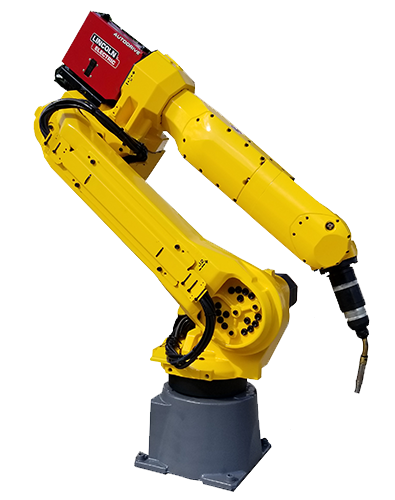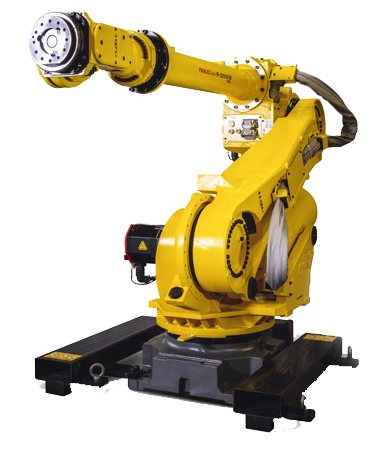Arc Welding
Robotic arc welding accounts for nearly twenty percent of welding robot applications. While there are several types of arc welding processes, they all involve permanently joining metals together through the use of electricity. A welding power supply generates the electricity needed to create an electric arc between the electrode and base metal. The electric arc produces the heat needed to melt the metals. Once they metals have cooled, they are bonded together. Types of arc welding applications include MIG, TIG, flux cored, and plasma welding. The FANUC Arcmate 100ic and the Motoman MA1400 are two popular welding robots for automating arc welding applications.Depending upon the exact type of arc welding application, a consumable or non-consumable electrode will be used. Some arc welding processes will require the use of a filler metal while others may not. Since arc welding requires more consumables it often has higher costs of the two robotic welding processes. Other disadvantages of arc welding are that is can be more time consuming, requires surface refinishing of workpieces, and can be hazardous. Due to the flux used, slag often forms on the weld joint and must be removed using a finishing process for a clean weld seam. Hazards from arc welding include intense light from the arc and excessive heat. Automating with a FANUC Arcmate 120ic removes operators from these hazards, but additional safeguards are still needed. This is why many users will often opt for a weld cell to enclose the articulated robot and protect floor workers.
Advantages of arc welding include the ability to weld a variety of metals regardless of thickness or location. Arc welding processes may be used to join dissimilar metals together or metals that are thicker. It also produces an incredibly durable weld. Generally most arc welding robots are six axis robots. In addition, many used welding robots for sale come integrated with a robotic welding supply. It is very common to final used FANUC welding robots for sale that already have an integrated Lincoln Powerwave i400 or Powerwave 455m. Most used Motoman welding robots for sale include a Miller produced welding supply like the Miller Auto-Axcess 450.
Resistance Spot Welding
Resistance spot welding makes up the majority of welding applications that are automated by robots. Unlike arc welding, which is a form of liquid state welding, robotic spot welding involves the joining of metals together in solid form. During spot welding metal workpieces are clamped together through applying pressure. An electrical current creates resistance from the workpieces which causes them to heat and permanently fuse together. Unlike arc welding, spot welds are concentrated to a small area of a workpiece. The FANUC R2000 can be commonly found along automotive production lines spot welding automobile components.Spot welding uses a non-consumable electrode to produce a current and does not require the use of a filler metal. With fewer consumables and less setup, robotic spot welding tends to be more cost-effective than arc welding. It is also a quicker process than arc welding as welds can be completed within seconds and there is no slag that must be removed from the workpiece. Another advantage of spot welding over arc welding is it is more energy efficient, using less heat and concentrating that heat to a particular area of the part. Concentrating heat to one spot also reduces the risk of distorting the metal. Many ABB robots for sale already have spot welding equipment integrated into them as they were taken from large automotive lines.
There are some disadvantages to robotic resistance welding. The types of metals that can be welded are limited to steel and stainless steel. Spot welding also is not recommended for metals that are thicker than 3 mm, which is why it is mainly used for welding sheet metal.
Robots Done Right is the place to start when it comes to used robots. Contact us if you are interested in buying or selling a welding robot.

